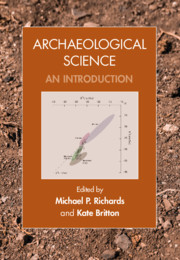Book contents
- Archaeological Science
- Archaeological Science
- Copyright page
- Contents
- Figures
- Tables
- Contributors
- Acknowledgements
- Part I Introduction
- Part II Biomolecular Archaeology
- Part III Bioarchaeology
- Part IV Environmental Archaeology
- Part V Materials Analysis
- 14 Ceramics
- 15 Glass
- 16 Metals
- 17 Lithics
- Part VI Absolute Dating Methods
- Index
- References
15 - Glass
from Part V - Materials Analysis
Published online by Cambridge University Press: 19 December 2019
- Archaeological Science
- Archaeological Science
- Copyright page
- Contents
- Figures
- Tables
- Contributors
- Acknowledgements
- Part I Introduction
- Part II Biomolecular Archaeology
- Part III Bioarchaeology
- Part IV Environmental Archaeology
- Part V Materials Analysis
- 14 Ceramics
- 15 Glass
- 16 Metals
- 17 Lithics
- Part VI Absolute Dating Methods
- Index
- References
Summary
Human produced glass was first regularly produced in Egypt and the Near East in the sixteenth century BC. It is often brightly coloured and was of high value, rating as a precious stone. As such, its study has the potential to not only give valuable information about technological ability and transfer, but also to map out exchange networks, especially if the sites where the glass was made can be identified and characterised. Therefore, glass is an important part of the archaeological assemblage, and an increasing amount of work has been devoted to it, especially over the last twenty or so years (Rehren and Freestone 2015).
- Type
- Chapter
- Information
- Archaeological ScienceAn Introduction, pp. 347 - 364Publisher: Cambridge University PressPrint publication year: 2020
References
- 1
- Cited by



